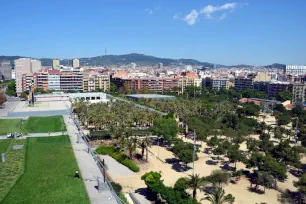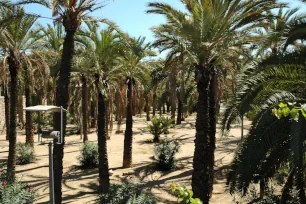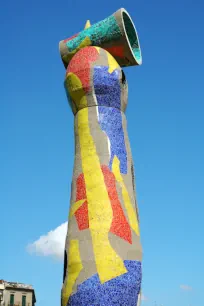Built in homage to one of Barcelona’s favorite native sons, Parc de Joan Miró is a tribute to the surrealist imagination of this twentieth century painter and sculptor. The park’s centerpiece is a large, colorful sculpture known as Dona i Ocell.
About Miró



Joan Miró was born in Barcelona in 1893 and studied at the Barcelona School of Fine Arts and the Academia Galí. His early works were reminiscent of Catalan folk art, yet one could detect the flavor of cubism in his paintings. After he moved to Paris and studied there in the 1920s, he began to develop what was to become his signature style, Surrealism. He also experimented with other media besides painting, including etchings, lithographs, and ceramic sculptures. Miro died in 1983.
The Park
The area where Parc de Joan Miró now sits was, until 1979, the location of a municipal slaughterhouse. Because of that, it was originally named Parc de l’Escorxador (Slaughterhouse park).
Covering four city blocks, this expansive park consists of two levels. The lower level is landscaped with pine, palm, fragrant eucalyptus trees and a pergola covered in wisteria and bougainvillea. The upper level is paved and contains the park’s crowning glory, one of Joan Miró’s last sculptures, entitled Dona i Ocell (Woman and Bird).

‘Dona i Ocell’ Sculpture
The starkly modern statue stands about twenty-two meters (70 feet) tall and sits on a simple island in the middle of a small pool. As is common in Miró’s works, the sculpture is covered with glazed ceramic tiles in bright, basic colors of yellow, red, and blue. The sculpture was complete in 1982, just a year before Miró’s death at age ninety.
Originally, the idea was to put a forest of sculptures like these in the park, but Joan Miró’s death prevented these plans from being implemented.
Fundació Joan Miró
Many of the Catalan surrealist artist’s works can be found in the Fundació Joan Miró, a museum located in the Parc de Montjuïc.
- Next: Plaça Reial
- More Sights & Attractions in Barcelona

